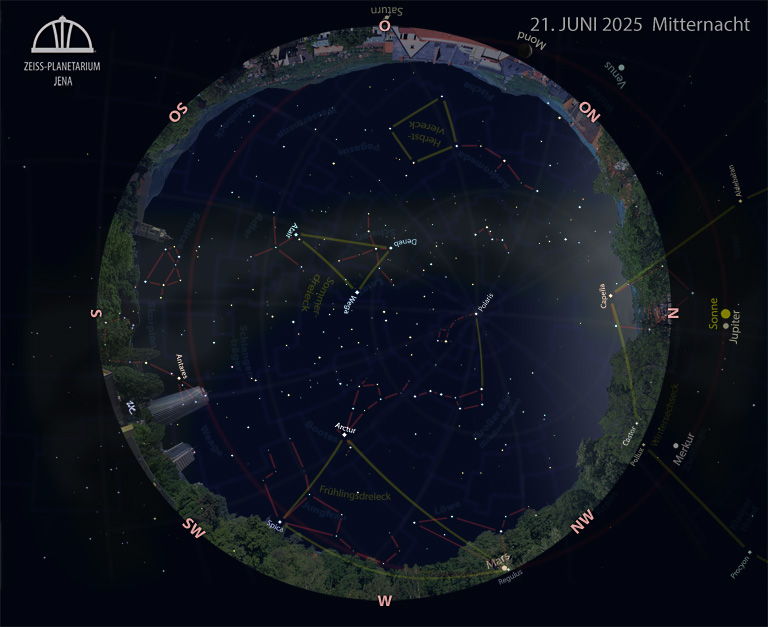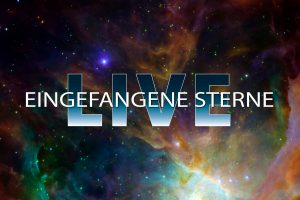Sommersonnenwende
Zu Mitternacht steht die Sonne nur etwa 16 Grad unterhalb des Nordhorizonts. Das bedeutet, dass das Ende der astronomischen Dämmerung in unseren Breiten nicht ganz erreicht wird, die Nacht nicht völlig dunkel wird. Im hohen Norden führt das zu den „Weißen Nächten“ und nördlich des Polarkreises zur „Mitternachtssonne“. In Jena beginnt der diesjährige Sommer astronomisch am 21. Juni um 4:40 Uhr MESZ. Die Sonne zieht vor dem Tierkreissternbild Stier in Richtung Zwillinge.
Vollmond ist am 11., Neumond am 25. Juni.
Unter günstigen Bedingungen können wir bis Anfang Juli in der Dämmerung im Nordwesten den raren Merkur, den innersten Planeten unseres Sonnensystems, entdecken. Mars ist Planet der ersten Nachthälfte, bewegt sich rechtläufig vor dem Tierkreissternbild Löwe und geht schon etwa Mitternacht im Westen unter.
Bald verabschieden sich am Westhorizont die Sterne des Frühlingsdreiecks, Regulus im Löwen, Spika in der Jungfrau und Arktur im Bootes.
Im Süden funkelt der rötliche Antares im Tierkreissternbild Skorpion. Hoch darüber sind es die hellen Sterne des Sommerdreiecks: Deneb im Schwan, Wega in der Leier und Atair im Adler. Deutlich tritt das „Kreuz des Nordens“ in der Figur des Schwans hervor.
Die Sterne des Herbstvierecks erscheinen morgens im Osten.
Im Osten erscheint der rechtläufige Ringplanet Saturn vor dem Tierkreissternbild Fische.
W. Don Eck
Zeiss-Planetarium Jena
The starry sky in June 2025
Summer solstice
At midnight, the sun is only about 16 degrees below the northern horizon. This means that the end of astronomical twilight is not quite reached in our latitudes and the night is not completely dark. In the far north, this leads to the „white nights“ and north of the Arctic Circle to the „midnight sun“. In Jena, this year’s summer begins astronomically on 21 June at 4:40 a.m. The sun moves in front of the zodiacal constellation Taurus in the direction of Gemini.
Full moon is on 11 June, new moon on 25 June.
Under favourable conditions, we can discover the rare Mercury, the innermost planet in our solar system, in the twilight in the northwest until the beginning of July. Mars is the planet of the first half of the night, moves prograde in front of the zodiacal constellation Leo and sets in the west at around midnight.
Soon the stars of the spring triangle, Regulus in Leo, Spika in Virgo and Arcturus in Bootes, will bid farewell on the western horizon.
In the south, the reddish Antares sparkles in the zodiacal constellation of Scorpius. High above are the bright stars of the summer triangle: Deneb in the Swan, Vega in the Lyre and Atair in the Eagle. The „Northern Cross“ is clearly visible in the figure of the swan.
The stars of the autumn quadrilateral appear in the east in the morning.
In the east, the orbiting ringed planet Saturn appears in front of the zodiacal constellation of Pisces.



